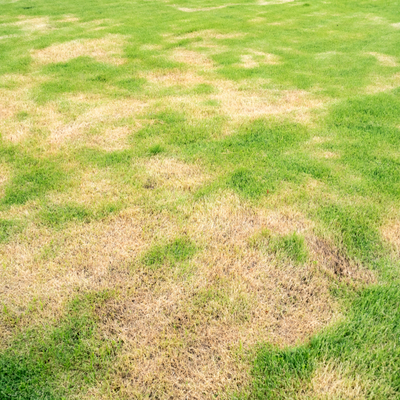Winter in Texas may not mean heavy snowfall and harsh winds like they see in the north, but there are still plenty of things that destroy our lawns. From mildew to fungus, we’ll show you six of the most common Texas lawn diseases to watch out for. 
Lawn Diseases Of North Texas
Dollar Spot
Typically, dollar spot appears in lawns in late winter, early spring when daytime temperatures become higher and more humid, while nighttime temperatures stay on the cooler side. This moisture-prone weather creates the ideal conditions for Dollar Spot to grow. Signs of Dollar Spot are small patches of white, tan, or bleached grass on your lawn. These spots are not bigger than a silver dollar – which is also how they got their name.
Large Patch
Until very recently, Large Patch was considered the same disease as Brown Patch. However, lawn care experts now understand that Large Patch only affects warm-season grasses, which we have in abundance here in Texas. Common warm-season grasses include Zoysia grass, Centipede grass, St. Augustine grass, and Buffalo grass. Like most Texas lawn fungus, Large Patch causes large, irregularly-shaped discolored areas in your lawn. As you may have guessed from the name, these areas can be as large as 25 feet in diameter. It can be tricky to treat, but aeration, mowing at the correct height, good fertilization, and a careful watering plan can all combat Large Patch.
Brown Patch
In keeping with the tradition, the name “Brown Patch” very aptly describes what to look for in your lawn: large brown patches. This is a common lawn disease during Texas winters. Unlike Large Patch, which, as we mentioned, only affects warm-season grasses, Brown Patch affects all varieties. Cold and damp weather are the leading culprits of brown patch, so resist the urge to give problem areas extra water. Consider aerating or hatching the area to allow wind and sunlight to dry out all the excess moisture.
Fairy Ring
No, this common lawn problem is not caused by small mischievous beings. Like the other diseases we’ve discussed, it’s caused by a fungal infection. Common symptoms of Fairy Rings in your lawn include large circles of dark green or dying grass. Around those rings are another layer. You may find a ring of mushrooms in one of the circles, which is why this problem is called Fairy Rings. Unfortunately, like fairies, this disease is tricksy. The affected area becomes water repellant or “hydrophobic,” which means watering the dead grass will have no effect. If untreated, Fairy Rings will return stronger each season. Aeration is the key, like with many other fungal infections, because it allows water to penetrate this hydrophobic layer and get to the grass’s roots. 
Powdery Mildew
Common in shady areas, Powdery Mildew spreads quickly and causes a – yes, you guessed it – white powdery substance on the tips of grass leaves. Infected grasses will slowly turn yellow and die off if untreated. If possible, reduce the amount of shade in your yard. If this is not possible, a fungicide may be necessary.
Centipede Mosaic
Unlike the other diseases we’ve listed, which are all caused by fungi, Centipede Mosaic disease is actually caused by a virus. Infected grass leaves will develop a speckled, mosaic-like pattern of white spots. Unfortunately, no chemicals currently exist to control viral infection in your lawn. However, you can replace infected areas with a more resistant variety of turfgrass. A lawn care professional can help you determine which grass mix variety is best for your situation.
Protect Your Texas Lawn From Diseases – Call Lawns-4-U
From disease protection to weed control to fertilizer, the experts at Lawns-4-U will keep your lawn looking its finest all year-round with our eight-step lawn care program. Call 972-859-0658 or contact us online to schedule an appointment! And for more lawn care tips, be sure to check out our monthly blog!
